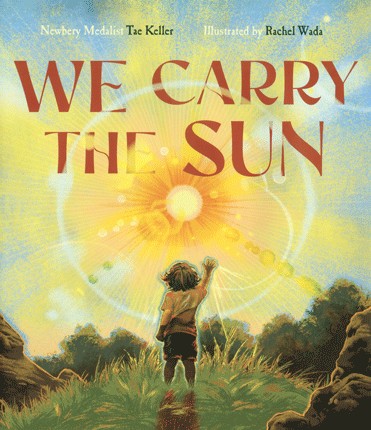| We carry the sun Author: Keller, Tae | ||
| Price: $23.28 | ||
Summary:
From the first human settlements to today's modern metropolises, we have always relied on the sun for light, energy, and sustenance. Traces the history of solar power from ancient south-facing villages to the Industrial Age and modern innovators; and from solar-powered steam engines to silicon solar panels.
| Illustrator: | Wada, Rachel |
Reviews:
Kirkus Reviews (08/01/25)
School Library Journal (07/25/25)
Booklist (00/05/25)
The Bulletin of the Center for Children's Books (00/06/25)
The Hornbook (+) (00/07/25)
Full Text Reviews:
Other - 03/17/2025 In this story of "how we reached into the sky/ and carried the sun home," Newbery Medalist Keller highlights the chain of insights that have led to accessible solar energy technology. Initial lines trace humans using the sun’s energy for warmth until "we begin to believe/ the sun is not enough," and communities turn to coal, "poisoning our planet." Following pages highlight innovators harnessing the sun’s energy across time-a teacher using a solar mirror to power a steam engine, a parent warming her baby’s bath in the sun, and more, each person advancing the science one step further. Short, telegraphic lines capture with force the powers keeping renewable energy from supplanting fossil fuels: "Oil companies prey/ on human weakness/ and pay politicians." Boldly outlined full-bleed portraits of inventors and technology by Wada (I Am Wind) represent brilliant sunlight, incorporating golden rays, halos, and sunspots. More than a resource about the history of solar energy, it’s also a look at stepwise progress made by standing on the shoulders of those who have come before. Characters are represented with various skin tones. An author’s note and solar energy timeline conclude. Ages 7-10. Author’s agent: Faye Bender, Book Group. Illustrator’s agent: Amy Tompkins, Transatlantic Agency. (June) - Copyright 2025
School Library Journal - 07/25/2025 K-Gr 3—Keller takes readers on a marvelous thought experiment, speculating about early humans and their ideas about the sun. Skipping forward in time to a colonial era, "we begin to believe the sun is not enough." Cue the Industrial Revolution and the burning of coal, a step in humanity that slowly, over centuries, poisons the earth. A French math teacher, Augustin Mouchot, wonders about the use of coal and how to harness the sun's energy more efficiently. Mouchot exits and a New Yorker named Charles Fritts, "two decades later," creates the world's first solar panel; engineer Aubrey Eneas tweaks the design; scientist Maria Telkes and her friend, architect Eleanor Raymond, come up with the first solar-heated home. The list of contributors builds; progress is not swift but solar energy becomes cheaper than fossil fuel. The premise of the story—how did solar energy come about—is somewhat obscured until the poetry gives way to lessons of more recent eras: corporate greed, lobbyists, activists, profits over promise, and other elements that prevent solar energy from taking hold. The luminous illustrations make clear how dire this is; then Keller's tone returns to optimism about people working together. Back matter includes an author's note and a solar energy time line. This is a complex but well-told story; the subsequent lecture, though necessary, on climate change and all our wrongdoings regarding the planet turn an eye-opening journey of collaborations across time and space into a pretty heavy lift for young readers. VERDICT This ambitious book will require booktalking but has STEM intrigue as well as a glimpse of how breakthroughs happen—not overnight, but in small, valuable increments. For that alone, this is an essential purchase.—Kimberly Olson Fakih - Copyright 2025 Publishers Weekly, Library Journal and/or School Library Journal used with permission.



